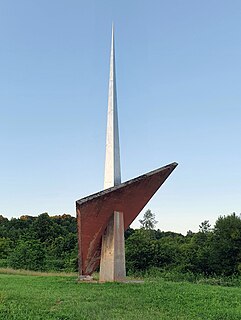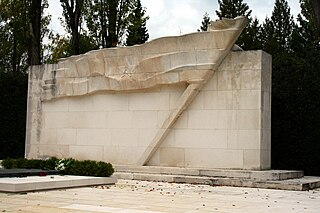 W
WDudik Memorial Park is a war memorial park located in Vukovar in eastern Croatia. The site is dedicated to 455 individuals who were executed by the authorities of the Independent State of Croatia during the World War II in Yugoslavia.
 W
WMonument to the Revolution of the people of Moslavina or simply Monument to the Revolution is a World War II memorial sculpture by Dušan Džamonja, located in Podgarić, Berek municipality, Croatia. It is dedicated to the people of Moslavina during World War II.
 W
WThe Monument to the Uprising of the People of Kordun and Banija is a World War II monument built on Veliki Petrovac, the highest peak of Petrova Gora (English: Peter's Mountain), a mountain range in central Croatia. The site of the monument is shared between three municipalities: Gvozd and Topusko, in Sisak-Moslavina County and Vojnić, in Karlovac County.
 W
WMonument to the revolutionary victory of the people of Slavonia or Monument to the people-hero of Slavonia is a former World War II memorial sculpture by Vojin Bakić, that was located in Kamenska, Brestovac, Croatia. It was destroyed in 1992.
 W
WMonument to the Fallen Fighters and Victims of Fascism from Slabinja, simply known as the Slabinja Monument, is a war memorial sculpture located in Slabinja, Sisak-Moslavina County, near Hrvatska Kostajnica, Croatia. The site is dedicated to 547 fallen soldiers and civilians of Slabinja who were killed during the World War II in Yugoslavia.
 W
WThe Stolpersteine in Croatia lists the Stolpersteine in the Republic of Croatia. Stolpersteine is the German name for stumbling blocks collocated all over Europe by German artist Gunter Demnig. They remember the fate of the Nazi victims being murdered, deported, exiled or driven to suicide.
 W
WStone Flower is a monument to the victims of Ustaša atrocities during World War II in Jasenovac. Designed by Bogdan Bogdanović and unveiled in 1966, it serves as a reminder of the atrocities perpetrated in the Jasenovac concentration camp.
 W
WThe Tomb of the People's Heroes is located in Zagreb's central graveyard, Mirogoj. It was designed by the Croatian sculptor Đuro Kavurić and built in 1968. Buried in the tomb are not only the recipients of the Order of the People's Hero, but also some of the most notable workers' movement activists of Croatia and Yugoslavia.